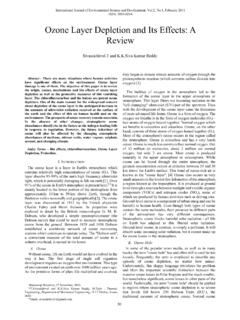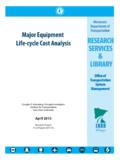Transcription of Determination of the Optimal Dosage of Aluminum Sulfate in ...
1 Abstract The process of coagulation and flocculation is one of the most important operations among the water purification process, but its effectiveness is affected due to the calculation of the coagulant Dosage which is performed by the Jar tests or the use of the Streaming Current Detector (SCD),having as main disadvantage that it does not take into account the change of the physiochemical parameters of the water in real time and also the need to obtain an Optimal operation point for the equipment . In this paper the Optimal Dosage of Aluminum Sulfate (Al2(SO4)3 18H2O) is determined using a model of Artificial Neural Network (ANN) that, when faced with real time variations of turbidity is able to calculate an indicated dose of coagulant, with the aim of achieve effective coagulation in the trial water and avoid excessive or insufficient presence of coagulant, minimize the need to make jars test continuously and reduce economic losses due to inadequate spending of coagulant.
2 The ANN created is able to calculate the Dosage based on the value of initial turbidity of the fluid to be treated with a MSE 0 mg/L, achieving removal percentages greater than 93% for most cases. Index Terms Aluminum Sulfate (Al2(SO4)3 18H2O), artificial neural networks, coagulation, flocculation, Optimal Dosage of coagulant. I. INTRODUCTION The potabilization process aims to offer safe water that fulfill the requirements established in the local regulations. Inside these processes, one of the most used and important in superficial waters is the coagulation and flocculation, which aims to eliminate turbidity in order to remove the suspended particles in water using flocculants [1]. To reach high levels of reduction is necessary to look for an Optimal Dosage of coagulant, which generally is calculated by means of the Jar Test, working under a uniform condition of turbidity.
3 However the turbidity values change temporarily on the water, affecting the effectiveness of this process, due to each turbidity value may need a different coagulant dose [2]. Coagulation and flocculation processes has been object of study and research by different approaches. One of these has been the application of artificial intelligence, through different computational tools like diffuse systems and neural Manuscript received May 5, 2015; revised July 20, 2015. A. J. Le n-Luque and C. L. Barajas G. are with the Faculty of Environmental Engineer, Santo Tom s Univeristy, Bogot , Colombia (email: C. A. Pe a-Guzm n is with the Department of Environmental Engineer, Faculty of Engineer, Santo Tom s Univeristy and Universidad Aut noma de Colombia, Bogot , Colombia (e-mail: networks [3]. Previous investigations have implemented Artificial Neural Networks satisfactorily in the calculation of the coagulant Dosage in Drinking Water Treatment Plants; in the case of Canada it was applied in the plant of Sainte Fox in the year 1997, with a group of four ANN, each one with a behavior learnt for each specific station, minimizing the need of Jar Tests to determine a coagulant dose [2].))
4 Other studies show the importance of the relation of some physicochemical parameters regarding the coagulant dose, this is the case of an Optimal dose program predictor based in the logic of the RNA implemented in Salisbury, Australia, which has the turbidity, color and alkalinity of the water as parameters of entrance of the network, giving a value of coagulant dose for each admitted stage [4]. Incidentally they have made several studies about the advantages of using artificial intelligence in order to optimize the calculation of the dose of coagulant using operation of treatment plants data as base for the design of each predictive model [5]. This article shows the use of an Artificial Neuronal Network as an alternative to determine the Optimal dose of coagulant for different concentrations of initial turbidity employing synthetic water, having the turbidity as the only intake variable simplifying the structure of the Artificial Neural Network.
5 II. MATERIALS AND METHODOLOGY. A. Determination of the Most Representative Physicochemical Parameters for the Calculation of the Optimal Coagulant Dosage The parameters selected were, in first instance, turbidity, because of its relationship with the colloidal particles or suspended material that affect the degree of transparency of the water; pH, since each coagulant has an Optimal range of pH within which the action turns out to be more efficient; alkalinity, because if the water has a high degree of alkalinity the reaction of coagulant gets affected; Color, because of the contribution of color made by the colloidal particles; water conductivity, as an indirect measurement of ions or dissolved solids present in the water and temperature, since the lower the temperature the longer it takes for flocculation of particles to occur. 1) Preparation of samples Sixteen samples were prepared under different levels of initial turbidity that was within the range of 10-1000 NTU, Determination of the Optimal Dosage of Aluminum Sulfate in the Coagulation-Flocculation Process Using an Artificial Neural Network A.
6 J. Le n-Luque, C. L. Barajas, and C. A. Pe a-Guzm n International Journal of Environmental Science and Development, Vol. 7, No. 5, May 2016346 DOI: of the Optimal Dosage of Aluminum Sulfate (Al2(SO4)3 18H2O) for Different Scenarios by Jar Test which is a characteristic range of the rivers in Colombia. The samples were defined as follows: 10, 28, 46, 64, 82, 100, 180, 260, 340, 420, 500, 590, 670, 760, 840, and 1000 NTU. These levels were obtained by adding different samples a certain volume of artificial water that was prepared with different proportions of water, sand, clay and powdered refreshment drink (made up of sweetener, colorant and flavoring), in order to simulate suspended solids, color and organic composition usually found in water that is submitted to purification. When the samples were prepared, we proceeded to setup the Jar Test with 10 beakers with 500 ml of water.
7 Aluminum Sulfate Al2(SO4)3 18H2O in a granular form was used as coagulant, and it was applied in samples in liquid form, this is why its preparation was necessary at a concentration of 5000 mg/L, in which 1ml applied on a sample of 500 ml represents a concentration of 10 mg /L. 2) Jar test First of all, a Jar Test was performed for each initial turbidity level defined above, meaning that 16 experiments were carried out overall. The first seven experiments (from 10 NTU to 180 NTU) were made with six samples or jar each and the nine remaining experiments (from 260 NTU up to 1000 NTU) were performed with a setup of 10 samples for each test. The Dosage of Aluminum Sulfate applied for each experiment started at 10 mg/L, with an increase of mg/L between each sample. However starting from the experiment number 9, corresponding to 340 NTU, it was necessary to increase the Dosage because this was insufficient for that level of turbidity and therefore did not showed good results of removal.
8 TABLE I: Dosage OF AL2(SO4)3 18H2O FOR EACH EXPERIMENT Initial Turbidity (NTU) Dosage Al2 (SO4)3 18 (mg/L) 10-180 10, 15, 20, 25, 30 y 35 260-340 10, 15, 20, 25, 30, 35, 40, 45, 50, 55 420-590 35, 40, 45, 50, 55, 60, 65, 70, 75, 80 670 40, 45, 50, 55,60, 65, 70, 75, 80, 85 760 840-1000 50, 55, 60, 65, 70, 75, 80, 85, 90, 95 55, 60, 65, 70, 75, 80, 85, 90, 95, 100 After preparing the samples, a Jar Test was carried out for each level of initial turbidity defined above, where a certain amount of coagulant was added to each beaker. For the first seven experiments, which range from the 10 NTU to 180 NTU, six samples were prepared for each test and the concentration of Aluminum Sulfate were added from 10 mg/L to 35 mg/L, with a variation of mg/L between each sample. For the nine remaining experiments with turbidity levels ranging from 260 to 1000 NTU, 10 samples setups were put in place for each level of turbidity.
9 Then, rapid mixing was carried out at 70 rpm during one minute intervals in order to homogenize the distribution of coagulant throughout the beaker and trigger the particle agglutination process. The slow mixing was done at a speed of 30 rpm during 15 minutes intervals to ensure the joint of the small flocs formed in the coagulation, which were allowed to sediment for 20 minutes. After finishing the Jar Tests with each of the samples, the reference parameters for coagulation and flocculation were measured again (pH, conductivity, turbidity, temperature, alkalinity and color) in order to determine the coagulant Dosage that caused the highest percentage of turbidity removal, in other words the concentration of alum that showed the lowest level of turbidity in a sample of each of the 16 experiments. 3) Determination of Optimal coagulant Dosage Having defined an initial Optimal dose, we proceeded to refine this dose, for this means we set it up using 10 different jars.
10 In the jar positioned by number five, we added a dose exactly equal to the initial Optimal dose obtained; for the four jars located to its left we added a lower dose lowering per jar at a time and, for the five jars by the right, we increased the dose in ml per jar. This procedure was made tripled for each of the 16 levels of turbidity initially defined and it was performed in order to achieve the optimization of the coagulant Dosage that would be entered in the creation of the Artificial Neural Network (ANN). C. Determination of the Optimal Dosage for Different Scenarios through Artificial Neural Network Taking into Account the Input Parameters Established 1) Relation of input parameters selected with coagulant Dosage With the results of the measurements of each of the selected parameters a correlation matrix was made, using MatLab, between the coagulant Dosage for each level of turbidity against each physicochemical parameter, which allowed to establish the degree of correlation of each of the parameters compared to the behavior of the Optimal coagulant Dosage and in turn with the final turbidity level.









